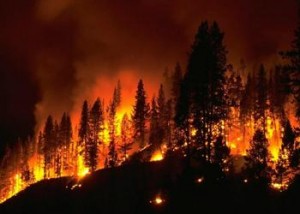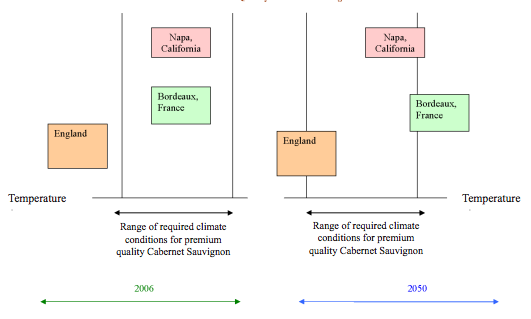During the holiday season many of us enjoy the company of family and friends with food and wine and a friend suggested I look at the link between wine making and climate change.
Winemakers are perhaps one of the groups who have been most attune to shifting weather patterns in the past and are paying close attention to changes in the climate. In an academic paper, Cornell University’s, Ramon Mira de Orduña, makes reference to studies which have looked at over 500 years of wine making records and discusses the impact of climate change on grapes and wine.
Grapes are being harvested between 2 and 3 weeks earlier in parts of Germany, California, and France where, for example, average temperatures were reported to increase by 1.8 ºC between 1972 and 2002 in the Alsace region.
In his paper, Dr. Mira de Orduña shows why grapes are directly sensitive to temperature, levels of CO2 and the amount of solar radiation they receive. In addition climate change can indirectly y affect wine making by changing the salinity of water when rainfall is replaced with irrigation, altering the prevalence of pests and disease,and even changing the taste of wine due to excessive smoke in the presence of wildfires.
y affect wine making by changing the salinity of water when rainfall is replaced with irrigation, altering the prevalence of pests and disease,and even changing the taste of wine due to excessive smoke in the presence of wildfires.
Last summer, for example, over 1 million acres (400,000 Hectares) of forest burned in Oregon State alone and the local wine industry is concerned about the impact of the smoke on their product as reported by the Oregon Wine Press and Wine Folly, a website.
The future of wine?
In a study published in 2013, Lee Hannah, of the University of California, Santa Barbara and others published a paper which forecasts deep declines in wine production in traditional wine making regions of Australia, Europe, and California as well as the opening up of a number of new arts of the world where wines should flourish if the models on which the research is based turn out to be accurate.
 Dr. Hannah is a leader in the relatively new field of climate change biology and the author of a textbook by the same name. The objective of research in this area is to determine what the affects of climate change are on plants and animals in order to inform efforts at reversing and mitigating climate change.
Dr. Hannah is a leader in the relatively new field of climate change biology and the author of a textbook by the same name. The objective of research in this area is to determine what the affects of climate change are on plants and animals in order to inform efforts at reversing and mitigating climate change.
Another team of researchers at the University of California at Davis, looked at the impact that climate change could have on California’s wine industry which produced 224.9 million cases in 2014 worth almost $ 25 Billion and employed 330,000 people.
That study, done in 2005, looked at how climate change could effect both the costs of making wine in different parts of the world and also the price as certain varietals may become less available. The chart below shows, for example, how Bordeaux may not be the best place to grow Cabernet Sauvignon in 2050!
Threat or Opportunity?
Like many aspects of climate change, its impact on wine making is both a threat and an opportunity. On the one hand traditional wine making regions may be adversely affected. On the other, new regions will become more attractive.
Tattinger, the award winning Champagne house that has been in business since 1773, has just announced for example, the purchase of 69 hectares in Kent for the production of sparkling wine and the FT reports that British wines are doing very well thanks to the changing climate!


